Not imaginary tales but evidence unearthed in excavations should be the basis of resolving Ayodhya dispute
Till now, there were two claimants to the disputed land in Ayodhya – one wants a temple to be built there while the other says that a mosque should come up. However, now, a third claimant has emerged, who wants a Buddha memorial to be built at the spot. The Supreme Court has admitted his petition to this effect, and it will be considered when the court takes up the Ayodhya case from 3 January 2019. The petitioner, Vineet Kumar Maurya, reveals the basis of his claim:

First, we would like to know what made you file this petition.
You see, I live in Ayodhya, and our house shares its boundary wall with that of the disputed site. The site is my immediate “neighbor”, and I used to visit it often. I have developed a sort of affection for it. When, in 2002, the site was being levelled on the orders of the High Court, I was also a part of the workforce as a tractor driver. At that time, some remains were found there, which were unofficially determined to be of the Ashokan era and linked to Tathagat (Lord Buddha). The Archaeology department did not categorically say that they were Buddhist remains but did not deny it either. In 2010, the department admitted before the High Court that Buddhist remains were discovered, but this was not made public on the pretext that it would disturb peace and tranquility.

How can you say that the Archaeology department had admitted this?
The excavations were done in 2002-03 on the orders of the Allahabad High Court. As I was working there, I saw everything with my own eyes. A survey report was prepared jointly by the Archaeological Survey of India and a Japanese company called Tojo-Vikas International, which said that Buddhist remains were found there. The report is in the custody of the court in a sealed cover. As soon as it is opened, the truth will be out.
I cannot say anything for certain but what struck me as odd was that though the original plan was to dig at 150 points, the work was stopped after only 50 pits were dug up. Was it because the purpose had been served and all required evidence had been collected? This question is unanswered to date.

The Archaeology department is yet to say anything about Buddhist remains being discovered. Then, what is the basis of your claim?
I was present at the time of the excavation, and my claim is based on what I saw and felt. I have moved the Supreme Court on the same basis. It is my firm belief that the disputed site belongs to the Buddhists and that the Hindus and Muslims are claiming it to be theirs without any justification. I want to ask them that if the mosque was constructed there in 1528, then, when was the temple was built and what existed there before the temple came up?
What you see and feel cannot be the basis of a lawsuit. The court will demand solid evidence.
I believe that what is a historical truth should come to light. The dirty games being played in the name of caste and religion should end, and the dispute should be resolved only by archaeological evidence. Let us not quarrel over whether it is Ram Janmabhoomi or Babri Masjid. We should focus only on the evidence. We are making this claim on the basis of the diggings at 50 points up to a depth of 10 feet. The remains found there were of the Ashokan era. The bricks, walls, stupas, and pillars – all indicate that it was a Buddhist place.

Are you saying that neither a temple nor a mosque should come up at the disputed site?
This is for the Supreme Court to decide. We are only adducing evidence to back our claim. The second and the third parties, too, can put up their claims and wait for the court’s verdict. They should behave logically. They have every right to have what is theirs. However, why issue threats?
What do you mean by threats?
In our petition, we have said nothing derogatory about any Hindu god or goddess or Allah. We have only furnished arguments. The matter is for the Supreme Court to decide – not for the Muslims or the Hindus. So, saying things like “we will kill you”, “we will hack you to death” should be avoided. Threats will not work. They should not be under the misconception that only the Savarnas have the monopoly over Hindu religion. Caste system needs to be uprooted.
Do you have any formula for resolving the dispute?
Let the decision be based on the evidence. Remains of a temple or any Hindu place of worship have not been found there. However, Buddhist remains have been found. This shows that at one time a Buddhist Vihara existed at that place. So, like Kapilvastu, Kushinagar, and Sarnath – the disputed site should be declared a Buddhist Vihara. This is not a formula. If a conclusion is reached on the basis of facts and evidence, where is the scope for any dispute?
After Union minister Ramdas Athavale, BJP MP from Bahraich, Savitribai Phule has also demanded the construction of Buddhist temple at Ayodhya. Your take?
We are not in politics. So, I will not react to what the politicians are saying. The stands of the political parties keep on changing. Somehow, I cannot believe that what they are saying is what they want. I am sorry, but I won’t comment on politicians. We want the people’s support, not of the leaders. We have the supporters of the Buddhists of Ayodhya, and with their help, we will take our battle ahead.
A personal question. How do you make a living?
I take Babasaheb Ambedkar’s thoughts to homes. I also conduct marriage, mundan and other ceremonies. If any programme on Ambedkar is held in my area, I put up a bookstall there. This yields enough to make ends meet. I am unmarried and am committed to treading the path showed by Ambedkar. And I will continue to walk this path till my last breath.
Translation: Amrish/copy-editing: Lokesh
Forward Press also publishes books on Bahujan issues. Forward Press Books sheds light on the widespread problems as well as the finer aspects of Bahujan (Dalit, OBC, Adivasi, Nomadic, Pasmanda) society, culture, literature and politics. Contact us for a list of FP Books’ titles and to order. Mobile: +917827427311, Email: info@forwardmagazine.in)
The titles from Forward Press Books are also available on Kindle and these e-books cost less than their print versions. Browse and buy:
The Case for Bahujan Literature
Dalit Panthers: An Authoritative History






